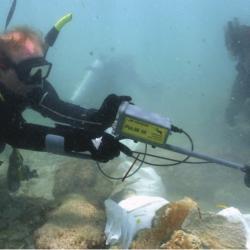Source Institutions
Source Institutions
Add to list Go to activity
Activity link broken? See if it's at the internet archive

In this archaeology activity, learners consider ways in which excavating an underwater site is different from excavating a terrestrial site. Through experimentation, learners discover new techniques that are important when dealing with this unique kind of archaeological site. This activity is featured on pp.57-60 (part of a lesson that begins on p.55) of the "Treasures of the Earth: Discover Clues to the Past" unit of study for grades 3-5 and 6-8.
- 5 to 10 minutes
- 45 to 60 minutes
- $5 - $10 per group of students
- Ages 8 - 14
- Activity, Experiment/Lab Activity, Lesson/Lesson Plan
- English
Quick Guide
Materials List (per group of students)
- bucket
- clear pan
- pennies (5-7 per group)
- sand
- water
- 60 cc syringes (no needles)
- straws
- brushes
- trowels
- other tools as appropriate
- maps or globes
- The Truth About Captain Kidd reading (page 58)
- Map of Catalina (page 72)
- Excavating Underwater handout (page 73)
Subjects
-
Earth and Space Science
-
Earth Structure
- Oceans and Water
-
Earth's History
- Archeology
-
Earth Structure
-
Engineering and Technology
-
Engineering
- Ocean Engineering
- Technology
-
Engineering
-
Mathematics
-
Data Analysis and Probability
- Data Analysis
- Data Collection
-
Data Analysis and Probability
-
The Nature of Science
-
The Scientific Process
- Conducting Investigations
- Gathering Data
- Formulating Explanations
- Communicating Results
- Science as a Career
-
The Scientific Process
-
The Nature of Technology
-
Technology and Society
- Technology and History
-
Technology and Society
Audience
To use this activity, learners need to:
- see
- read
- touch
Learning styles supported:
- Links STEM to other topics of interest such as arts and humanities
- Involves hands-on or lab activities
Other
Includes alignment to state and/or national standards:
This resource is part of:
- Classroom Resources
- Treasures of the Earth: Discover Clues to the Past (A Unit of Study for Grades 3-5 and 6-8)
Access Rights:
- Free access
By:
Rights:
- All rights reserved, The Children's Museum of Indianapolis, 2011
Funding Sources:
- AAA Insurance
- Indianapolis Honda Dealers
- Key Bank
- National Geographic
